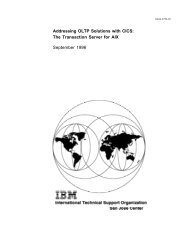install–38 - Ibm
install–38 - Ibm
install–38 - Ibm
Create successful ePaper yourself
Turn your PDF publications into a flip-book with our unique Google optimized e-Paper software.
esponses from every IP address in the subnet,<br />
especially for IP addresses where no devices are<br />
present. There might, however, be times when a full<br />
subnet sweep will produce valuable diagnostic<br />
information about the network or a device’s<br />
configuration.<br />
switch. A fibre channel device that provides full<br />
bandwidth per port and high-speed routing of data by<br />
using link-level addressing.<br />
switch group. A switch and the collection of devices<br />
connected to it that are not in other groups. Switch<br />
Groups are discovered by the SANavigator tool and<br />
displayed with a gray background on the Physical and<br />
Data Path Maps.<br />
system name. Device name assigned by the vendor’s<br />
third-party software.<br />
TCP. See Transmission Control Protocol.<br />
TCP/IP. See Transmission Control Protocol/Internet<br />
Protocol.<br />
terminate and stay resident program (TSR<br />
program). A program that installs part of itself as an<br />
extension of DOS when it is executed.<br />
TFT. See thin-film transistor.<br />
thin-film transistor (TFT). A transistor created by<br />
using thin film methodology.<br />
topology. The physical or logical arrangement of<br />
devices on a network. The three fibre channel<br />
topologies are fabric, arbitrated loop, and point-to-point.<br />
The default topology for the disk array is arbitrated loop.<br />
TL_Ports. See translated loop port.<br />
translated loop ports (TL_Ports). Each TL_Port<br />
connects to a private loop and allows connectivity<br />
between the private loop devices and off loop devices<br />
(devices not connected to that particular TL_Port).<br />
Transmission Control Protocol (TCP). A<br />
communication protocol used in the Internet and in any<br />
network that follows the Internet Engineering Task Force<br />
(IETF) standards for internetwork protocol. TCP<br />
provides a reliable host-to-host protocol between hosts<br />
in packed-switched communication networks and in<br />
interconnected systems of such networks. It uses the<br />
Internet Protocol (IP) as the underlying protocol.<br />
Transmission Control Protocol/Internet Protocol<br />
(TCP/IP). A set of communication protocols that<br />
provide peer-to-peer connectivity functions for both local<br />
and wide-area networks.<br />
trap. In the Simple Network Management Protocol<br />
(SNMP), a message sent by a managed node (agent<br />
function) to a management station to report an<br />
exception condition.<br />
trap recipient. Receiver of a forwarded SNMP trap.<br />
Specifically, a trap receiver is defined by an IP address<br />
and port to which traps are sent. Presumably, the actual<br />
recipient is a software application running at the IP<br />
address and listening to the port.<br />
TSR program. See terminate and stay resident<br />
program.<br />
user action events. Actions that the user takes, such<br />
as changes in the SAN, changed settings, and so on.<br />
Each such action is considered a User Action Event.<br />
vendor. Property value that the SANavigator tool uses<br />
to launch third-party software. Vendor property might be<br />
discovered but will always remain editable.<br />
VGA. See video graphics adapter.<br />
video graphics adapter (VGA). A computer adapter<br />
that provides high-resolution graphics and a total of 256<br />
colors.<br />
video random access memory (VRAM). A special<br />
type of dynamic RAM (DRAM) used in high-speed video<br />
applications, designed for storing the image to be<br />
displayed on a computer’s monitor.<br />
VRAM. See video random access memory.<br />
WORM. See write-once read-many.<br />
Worldwide Name (WWN). A registered, unique 64–bit<br />
identifier assigned to nodes and ports.<br />
write-once read-many (WORM). Any type of storage<br />
medium to which data can be written only a single time,<br />
but can be read from any number of times. After the<br />
data is recorded, it cannot be altered. Typically the<br />
storage medium is an optical disk whose surface is<br />
permanently etched by using a laser in order to record<br />
information. WORM media are high-capacity storage<br />
devices and have a significantly longer shelf life than<br />
magnetic media.<br />
WWN. See worldwide name.<br />
XGA. See eXtended graphics array.<br />
zoning. A function that allows segmentation of nodes<br />
by address, name, or physical port and is provided by<br />
fabric switches or hubs.<br />
Glossary 87
















